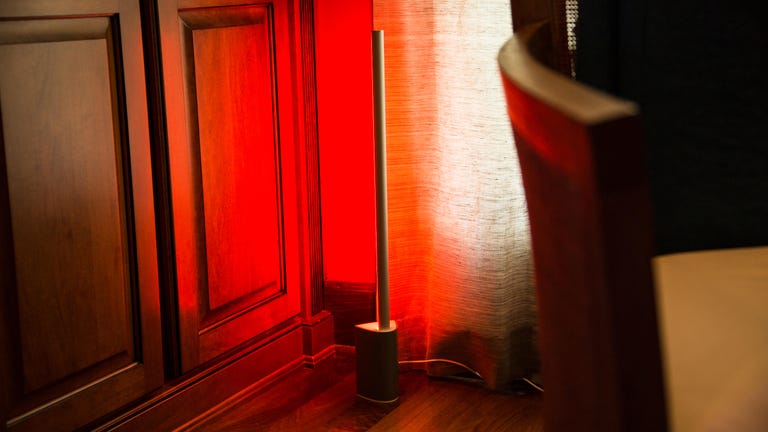 Why You Can Trust CNET
Why You Can Trust CNET Philips Hue Signe Floor Lamp review: I'm not sure who this Hue is for
It's strange, it's expensive, and it would look out of place in most homes. What's the point of this thing?
Sometimes, when a child misbehaves, their parent will make them stand and face the corner in a time-out. That's sort of what it was like testing out the new Philips Hue Signe floor lamp.
The Good
The Bad
The Bottom Line
Available as a 24-inch table lamp for $160 (about £125, or AU$220), or a 58-inch floor lamp for $250 (about £195, or AU$345), the new fixtures are basically vertical wands of light designed to spread color across your walls. And, in fairness, both Signe fixtures behaved perfectly well as I tested them out -- but I also didn't really know what the heck I was supposed to do with the things.
At any rate, into the corner the floor lamp went. I plugged it in and synced it up with the Hue app, then added it to the CNET Smart Home's Apple HomeKit setup. Like other Hue products, the Signe fixtures are compatible with Siri, Alexa, the Google Assistant and a number of other popular smart home platforms.
I asked Alexa to turn it on and off, then asked Google Assistant to dim it up to fifty percent. Siri changed it to blue. I automated it alongside other HomeKit-compatible products in the same room using Apple's Home app. Everything worked perfectly. Hue's always been about as rock-solid as smart lighting gets.
The CNET Smart Home is a big space, but I couldn't find a spot in it where the large-sized Signe looked good.
The problem is that I was left entirely underwhelmed. For a product that's meant to be aimed at your walls, each Signe fixture casts a fairly narrow pool of light. Turning them sideways helped a bit, but then I had a bright strip of LED's glaring into my eyes from my seat on the couch.
This is the Signe setup from the Philips Hue booth at the IFA 2018 tech showcase in Berlin. I can't imagine a home these would look good in.
The smaller, less expensive Signe makes a little more sense if you're hiding a pair of them behind either side of your TV, then using them in cohort with a Philips Hue light strip stretched along the top to create 3-point ambient bias lighting that syncs up with whatever you're watching. A setup like that would cost you $410, though -- and that's assuming you already own the mandatory Philips Hue Bridge, which doesn't come included with the Signe lights or the Hue light strips and costs an additional $60 on its own. I'd much rather save my money and go with the less expensive Hue Bloom or Hue Play directional fixtures for those sides-of-the-TV lights.
Still, no matter which ones I went with, I'd only be able to put out one color at a time from each light, because there still aren't any Philips Hue products that can put out multiple colors at once the way you can with competitors like Dreamscreen 4K or the Lifx Z Light Strip. The Signe fixtures are basically just rigid, vertical light strips -- if Lifx can make theirs multi-color, why not Philips?
In sum, these things just don't make much sense to me. I can't imagine the type of home they'd blend into, nor can I envision a compelling use case that justifies the high cost of buying in.
CNET's Holiday Gift Guide: The place to find the best tech gifts for 2018.
Best Black Friday 2018 deals: The best discounts we've found so far.


